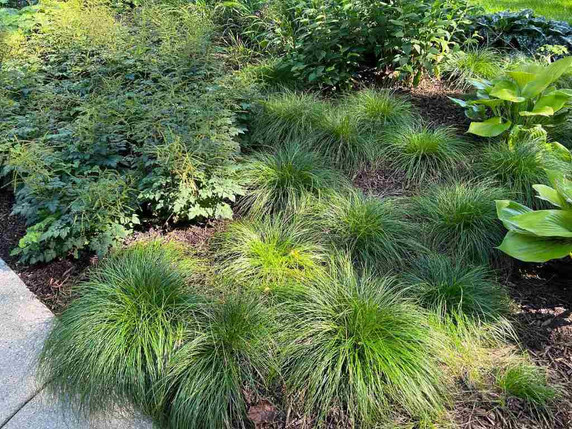Carex albicans - WHITE-TINGED SEDGE
One of several top performing sedges in Mt. Cuba trials - both in sunny location (4.1 point out of 5) and full shade (4.3 points out of five). Although plants in the full sun get older sooner and have to be divided.
Universal use, adaptable to soils and light conditions, ground-covering growth.
Prefers somewhat drier conditions - perfect candidate for dry shade garden and garden with difficult to identify light conditions (moving shade/sun during the day).
Due it's very fine texture goes well with any other perennials.
Blooming Time: May
Size: 1-1.5' high and wide clumps, slowly spreading
USDA Zones: 3 to 8
Culture: half shade to half to shade, average soil, very adaptable to soil types. Grows well even in the sun, but in time in full sun will develop older center (ring-shape growth) and has to be divided and renewed.
Moisture Needs: average (medium), medium-dry, drought tolerant
Origin: Central and Eastern USA, found in drier upland woodlands, see the BONAP distribution map
Black walnut tolerance: yes
Deer/Rabbit Resistant: yes / yes
Attracts Butterflies or Pollinators: no
Attracts Hummingbirds: no
Pot Size: square 3.5" x 4" deep pot
Picture copyright: Austin Eischeid Garden Design
Plant combinations: Very universal use in areas with some shade during the day. In masses or bigger groups, as a ground covering perennial, or substitute it in lawns in difficult spots. Some great perennial companions are Aquilegia canadensis, Asarum, Aster divaricatus, Brunnera, Dicentra, Epimedium, Helleborus, Heuchera, smaller hostas, Phlox divaricata, Persicaria, Primula, various spring ephemerals, ferns and others.

Carex albicans - WHITE-TINGED SEDGE
One of several top performing sedges in Mt. Cuba trials - both in sunny location (4.1 point out of 5) and full shade (4.3 points out of five). Although plants in the full sun get older sooner and have to be divided.
Universal use, adaptable to soils and light conditions, ground-covering growth.
Prefers somewhat drier conditions - perfect candidate for dry shade garden and garden with difficult to identify light conditions (moving shade/sun during the day).
Due it's very fine texture goes well with any other perennials.
Blooming Time: May
Size: 1-1.5' high and wide clumps, slowly spreading
USDA Zones: 3 to 8
Culture: half shade to half to shade, average soil, very adaptable to soil types. Grows well even in the sun, but in time in full sun will develop older center (ring-shape growth) and has to be divided and renewed.
Moisture Needs: average (medium), medium-dry, drought tolerant
Origin: Central and Eastern USA, found in drier upland woodlands, see the BONAP distribution map
Black walnut tolerance: yes
Deer/Rabbit Resistant: yes / yes
Attracts Butterflies or Pollinators: no
Attracts Hummingbirds: no
Pot Size: square 3.5" x 4" deep pot
Picture copyright: Austin Eischeid Garden Design
Plant combinations: Very universal use in areas with some shade during the day. In masses or bigger groups, as a ground covering perennial, or substitute it in lawns in difficult spots. Some great perennial companions are Aquilegia canadensis, Asarum, Aster divaricatus, Brunnera, Dicentra, Epimedium, Helleborus, Heuchera, smaller hostas, Phlox divaricata, Persicaria, Primula, various spring ephemerals, ferns and others.


